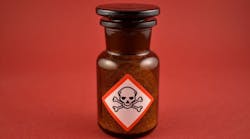We’ve carried a number of individual news items about state legislative bodies considering bans on ingredients added to food. Food safety consultancy The Acheson Group (www.achesongroup.com) has been watching the developments, too, and has come up with a master list of 23 substances “under the gun for exclusion in foods by a state or federal regulatory body.” And we’ve added a few of our own from our recent news stories to come up with a total of 28.
From the individual states (details below), the master list includes: azodicarbonamide, blue 1 & 2, brominated vegetable oil, butylated hydroxyanisole (BHA), green 3, high-fructose corn syrup, potassium bromate, propylparaben, red 3 & 40, titanium dioxide, yellow 5 & 6. (14)
On March 4, the FDA published its “List of Select Chemicals in the Food Supply Under FDA Review.” This list of 21 chemicals includes all those currently facing state bans except azodicarbonamide and butylated hydroxyanisole (BHA), which are in New York’s pending bill.
The FDA list: 3-monochloropropane-1,2-diol (MCPD) esters and glycidyl esters (GE); 4-methylimidazole (4-MEI); arsenic; bisphenol A (BPA); cadmium; fluorinated high-density polyethylene (HDPE); irgafos 168 (tris(2,4-di-tert-butylphenyl) phosphite); lead; mercury; mycotoxins; partially hydrogenated oil; PFAS (per- and polyfluoroalkyl substances); phthalates; thallium. (14)
If you use any of those, read on.
“The food chemical hit list is continuing to grow both geographically, as states continue to add bans, and by impact, as the list seems to lengthen each time another state seeks passage,” wrote The Acheson Group.
State-by-state, Acheson Group provides these highlights (with two additions from us):
- California Food Safety Act (AB-418), (Passed 10/9/23). Commencing January 1, 2027. No person or entity can manufacture, sell, deliver, distribute, hold, or offer for sale, in commerce a food product for human consumption that contains brominated vegetable oil, potassium bromate, propylparaben, or red dye 3. (Up to $5,000 for a first violation; up to $10,000 each subsequent violation)
- Illinois Prohibited Food Additives (SB2637 (second reading 2/22/24). Beginning January 1, 2027, a person or entity shall not manufacture, sell, deliver, distribute, hold, or offer for sale a food product for human consumption that contains brominated vegetable oil, potassium bromate, propylparaben, or red dye 3. (Up to $5,000 for a first violation; up to $10,000 each subsequent violation)
- An Indiana state representative has introduced HB1074, a bill to ban the use of high-fructose corn syrup in food and beverage products sold in that state. (Our addition to the TAG list.)
- New York Bill A6424A (amended/re-referred to Agriculture 2/22/24).Commencing one year after the effective date, it shall be unlawful for any person, firm, association, or corporation to manufacture, compound, brew, distill, produce, process, sell, deliver, distribute, hold, offer or expose for sale any of the following substances as food additives or food color additives or any food or food product containing azodicarbonamide, brominated vegetable oil (BVO), butylated hydroxyanisole (BHA), potassium bromate, propylparaben, Red 3, and titanium dioxide. (Dairy products containing titanium dioxide are exempted.)
- (Another of our additions) Two Pennsylvania state representatives introduced House Bills 2116 and 2117, which together would ban red 3, yellow 5 & 6, potassium bromate, brominated vegetable oil and butylated hydroxyanisole (BHA).
The Acheson Group notes, “We had some serious concerns around who is the leading authority, asking ‘Is it a federal agency charged with keeping current around risks in foods? Or is it a state which has significantly fewer resources and is not charged with protecting public health across the entire country?’
“That said, it does seem that our November predictions are coming to fruition: FDA is certainly seeming to take a stronger stance on chemicals in foods, particularly heavy metals. And with regulations pending in Illinois and New York (and likely being concocted in other states), it behooves manufacturers to abide by the strictest regulation for all their products, rather than trying to manufacture to a patchwork of regulations among states.”
The Acheson Group's full story is here.


